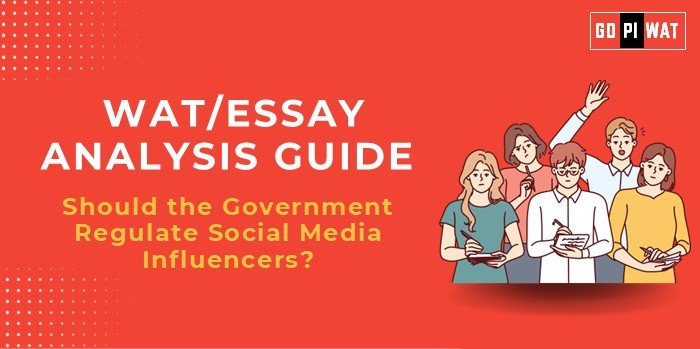📋 Should the Government Regulate Social Media Influencers?
🌐 Understanding the Importance of Influencer Regulation
The rise of social media influencers has transformed marketing strategies, making this topic pertinent for discussions on consumer protection, ethical advertising, and the role of government oversight in the digital age.
📑 Effective Planning and Writing
- ⏱️ Time Allocation:
- Planning: 5 minutes to outline key points and structure.
- Writing: 20 minutes to develop arguments and provide evidence.
- Review: 5 minutes to refine language, ensure clarity, and confirm the inclusion of verified data points.
- 🔍 Preparation Tips: Identify relevant statistics on influencer market growth, current regulatory practices in different countries, and potential ethical concerns arising from influencer marketing.
✨ Introduction Techniques for Essays
- Contrast Approach: “While influencers contribute to brand visibility and consumer engagement, their lack of regulation has led to ethical concerns, prompting discussions on the need for government intervention.”
- Solution-Based Approach: “With the rapid rise of influencer marketing, ensuring transparency and accountability has become critical. A balanced regulatory framework could address these needs while preserving creativity.”
- Timeline Introduction: “Influencer marketing has evolved significantly over the past decade, growing into a $21 billion industry. However, this rapid growth has exposed gaps in regulatory oversight, leading to calls for a government-led framework.”
📝 Structuring the Essay Body
🏆 Paragraph 1: Achievements
Topic Sentence: Highlight the economic contributions and innovation of influencer marketing.
Supporting Evidence: Data on market size and the economic impact of influencers, especially for smaller brands.
Impact Analysis: Discuss how influencers provide personalized marketing that enhances engagement and brand loyalty.
⚠️ Paragraph 2: Challenges
Problem Statement: Outline key ethical and transparency issues, including undisclosed sponsorships and misinformation.
Supporting Evidence: Cite examples and cases of consumer backlash due to misleading endorsements, especially in sectors like health and finance.
Implications: Examine the potential risks to consumers and the impact on the industry’s credibility.
🔍 Paragraph 3: Future Perspective
Current Status: Discuss existing guidelines in countries like the U.S. and U.K.
Global Comparison: Compare regulatory practices to explore effective solutions.
Recommendations: Suggest moderate government guidelines that encourage transparency while supporting influencer creativity and authenticity.
📄 Concluding Effectively
- Balanced Perspective Conclusion: “The need for influencer regulation is evident given the ethical challenges. A balanced approach that encourages transparency without stifling creativity could create a more sustainable and trusted influencer marketing landscape.”
- Global Comparison Conclusion: “As global standards for influencer marketing emerge, countries like India can benefit from adopting flexible, consumer-focused guidelines that uphold both transparency and creative freedom.”
📊 Analyzing Successes and Shortcomings
- Key Achievements: Emphasize the economic benefits and engagement value of influencers in digital marketing.
- Ongoing Challenges: Address ethical concerns and transparency issues that continue to affect consumer trust.
- Global Context: Show how countries with regulations in place, such as the FTC’s policies in the U.S., have successfully balanced these factors.
💡 Recommendations for Sustainable Progress
- 📢 Disclosure Requirements: Establish mandatory guidelines for clear labeling of paid partnerships to ensure transparency.
- 📜 Industry Self-Regulation: Encourage influencers and brands to adopt a code of ethics, promoting best practices within the industry.
- 📚 Digital Literacy Programs: Implement initiatives to educate consumers on identifying sponsored content, enhancing consumer protection.
📚 Sample Short Essays on Influencer Regulation
- Balanced Perspective: “Influencers have transformed the advertising landscape, yet the lack of transparency raises ethical questions. A government-regulated framework focused on disclosure could enhance consumer trust while preserving the authenticity that audiences value.”
- Solution-Oriented: “Mandatory guidelines for influencer disclosures could address transparency concerns effectively. Such measures would benefit consumers by clarifying paid partnerships without imposing restrictive policies on the industry.”
- Global Comparison: “Countries like the U.K. and U.S. have successfully implemented influencer regulations that promote transparency without stifling creativity. India could adopt similar approaches to foster a responsible, consumer-centered influencer market.”
🎓 Value to B-School Students
This analysis of influencer regulation offers insights into navigating ethical dilemmas, regulatory impacts on digital marketing, and the balance between creativity and responsibility. Students can explore themes of consumer protection, global regulatory trends, and ethical marketing practices—key considerations in modern business environments.


